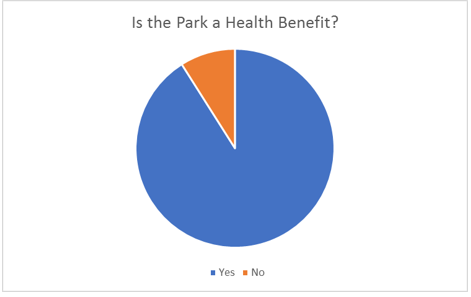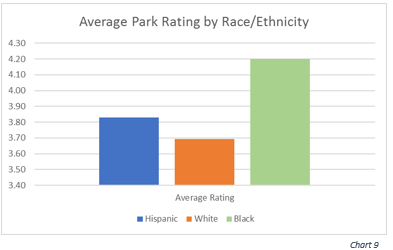ANALYSIS
The City of Pomona over the last 5 years has dedicated an average of approximately 5% of the annual budget toward the city’s parks [Table 6]. The money has been allocated for acquisition of new land for additional parks as well as maintenance and improvement of watering equipment and facilities. Notably in the 2015-2016 budget, over $3.1 million was allocated for improvements of Ganesha Park including a planting of a new tree grove and demolition of an outdated restroom facility (“City of Pomona - 2015-2016 Fiscal Budget” 2017). Pomona has attempted to maintain and improve their parks throughout the community and the surveyed parks show that. During assessment of each park, it was noted that the function and condition of the facilities, apart from the restrooms, were in fair to excellent condition.
Using the EAPRS tool was helpful and reliable in highlighting the conditions of the park and the scores across each of the seven surveyed parks show that Pomona has succeeded in maintaining fair to excellent conditions of their parks [Table 8]. Prior studies have found that parks within an area of high percentage of racial minorities tend to have a lower quality amenities than of those in primarily white neighborhoods (Engelberg et al. 2016). According to the assessment of Pomona park amenities within these seven parks, this conclusion was not met.

SURVEY RESULTS
Over the course of 14 days, a survey was conducted of park users at the same seven randomly selected parks. 7 questions pertaining to demographic information, reasons for visiting the park, frequency in visitation, and distance traveled were asked with a total number of respondents equaling 101. The purpose of this survey was determining what, if any, differences arose from demographics and park use. Other studies have come to the conclusion that within varying demographic groups, park use varies, especially when examining racial and ethnic groups (Das et al. 2017; Payne et al. 2002; Engelberg et al. 2016). Parks are more likely to be viewed as a health benefit if the respondent is of Hispanic origin than if they are white (Das, Fan, and French 2017) and age also determines the frequency of use in that with increased age, there is a decrease in park usage (Payne et al. 2002). Teens are also less likely to use the park than adults and children (Cohen et al. 2015) and time of day and weekday versus weekend use is also different (Veitch et al. 2012) and this was no different in Pomona. The number of users in the park varied greatly between weekday and weekend with predominantly more people during the weekend visits. The small neighborhood parks were not used during the weekday daytime hours, seeing most attendees during the evening hours in the middle of the week. The survey respondents (n=101) was consistent with the demographic breakdown of the city of Pomona (Chart 1) so the survey should be considered a fair representation

Consistent with prior studies, users of Pomona parks overwhelmingly saw the parks as a health benefit [Chart 2]. However, there was a slight difference between in that 89% of Hispanics saw the park as a health benefit versus 93% of White respondents. There was a disparity in the opinion of African American respondents in that only 80% saw the park as a health benefit.
This may contribute to the typical use of parks by demographic category as well. Hispanics and Whites versus African Americans use the parks for various reason (Das et al. 2017) and there are similarities in the survey results here [Chart 3].
When looking at the total numbers, sports and relaxation are the dominant reasons for people to attend the parks. However, the African American population doesn’t follow these trends.

Like previous studies (Payne et al. 2002), African Americans in Pomona use the park more often for social gatherings than for physical activity [Chart 4]. This was confirmed in Ganesha Park where all African American respondents were using the park for social gatherings.
The breakdown of age groups trends strongly with previous findings in that there is a decline in usage for teens and elderly citizens. The survey results [Chart 5] show that most survey respondents were adults between the ages of 19-65. Admittedly, this is not a clear breakdown of park users, merely survey respondents. A fair number of respondents were there with children who did not participate in the survey, so the 0-18 category is greater in number. However, there is a steep decline in park usage for the 66 and older crowd. This may stem from the desire of an older audience desiring more nature based recreation and exercise versus organized (Payne et al. 2002) making an urban park not a desired destination.
Overall ratings of the park were various across age groups as well. There was a decline in overall ratings for each park as the groups increased in age [Chart 6].
During the surveys, follow up questions were given to those who responded that rated the park poorly and the overwhelming response was due to the homeless and loitering issues within the parks. When speaking to the younger crowd (0-18, 19-24), little attention was paid to this issue and those who did rate the park poorly mentioned the restroom cleanliness and inaccessibility issue.
When examining the frequency of use, there is a disparity in other studies between racial and ethnic lines (Das et al. 2016; Engelberg et al. 2016). African Americans and Hispanics tend to use the park less often than Whites. The reason has been linked to typically poor quality and a lack of amenities in predominantly Black and Hispanic neighborhoods (Engelberg et al. 2016). However, this survey noted that parks had very similar amenities conditions across all demographic regions of Pomona. The 3-predominant racial and ethnic surveyed groups also had a slight disparity in frequency of use [Chart 7]. More whites labeled themselves as occasional users, while Hispanics and African Americans stated more often that they were frequent-to-daily users of the parks.
DISCUSSION
Park usage in the city of Pomona and the characteristics of demographics are consistent with previous findings in other studies. Based on survey results, 40.6% of park users were between 25 and 40. Over 65% of those surveyed were of Hispanic origin, consistent with Pomona’s breakdown. There was an even split of 32.7% in reasons for use for the seven parks visited between a sports activity and relaxation and meditation. Most visitors (74.3%) were either occasional or frequent users, but double the percentage of daily users were rare users of the park. Over 90% of those surveyed saw the park as a health benefit which is consistent with the finding that 55.5% of survey respondents were attending the park for some type of physical activity, either sports or recreation & playground use. Distance traveled to the park was also consistent with other findings (Van Dyck et al. 2013; Payne et al. 2002) that users are within close proximity to the park [Chart 8]. Over 41% of respondents were within two miles of the park. In hindsight, this question should have been modified to allow for a closer segment to be determined as we did find that many of those within 0-2 miles were within walking distance.
The final question that was addressed was overall assessment of the park on a 1-5 Likert scale with 1 being “poor; lacking in facilities”, 3 being “fair; most needs met”, and 5 as “excellent; all needs met. Great facilities”. As shown, the park rating declines as the survey respondents increased in age and there was also a divergence in opinions of the park based on race and ethnicity [Chart 9]. Hispanics and Whites had a less favorable few of the parks and with an average rating of 3.81 and 3.69 respectively. However, African Americans had a much more favorable few with an average rating of 4.20. This may be attributed to the 40% of the African American population uses the park for more social activities like family parties and may not utilize all of the parks amenities, which is consistent with the findings of prior studies (Payne et al. 2002).
But the primary concern of respondents of the survey, even those that rated the parks with a 4 or 5 score, was the prevalence of homeless and transient population within the parks. Every park surveyed with the exception of Powers Park had several transient people within the park and most appeared to have been in the park for some time. On the face of things, the assessment did show that Pomona’s parks are well managed, manicured, and maintained to an average to above average standard. However, the added element of people within the park space that is not using it for intended purposes left many respondents with a feeling of uneasiness and insecurity. There were several times that respondents mentioned that they would not come to the park in the evening or nighttime hours to avoid any conflict or dangerous situations. If the city of Pomona is to have their parks become truly excellent parks in a city that needs safe and secure park and recreation spaces, the issue of criminal and homeless activity in the parks needs to be addressed.






